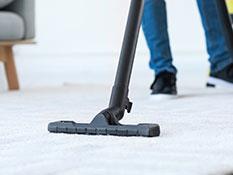Covid-19 og tæpper

Companies are opening gradually and therefore we have found some answers to the most common questions and recommendations about Covid-19 in relation to carpets, to make sure people can return to their workplace with confidence.
FAQ
How Covid-19 is transmitted?
The main transmission pathway of the novel coronavirus is droplet infection. The transmission can happen by being near an infected person talking, sneezing or coughing. Thus, physical distancing can minimize the risk of transmission.
Transmission is only possible when the virus has a carrier which is a liquid produced from either coughing or sneezing. This implies that virus can dry out when droplets disappear, and it is by no means dangerous.
What is the probability to be infected by Covid-19 via carpets?
The transmission probability of the transmission to the face via hands that have contact with potential contaminated carpets is very low and only possible in a short period before the droplets contaminations dry out.
Current available studies show that the virus half-life in aerosol is about 2.7 hours, and the virus are not longer infectious after a maximum of 3 days.
What is the advantage of carpets compared to other types of surfaces?
Unlike for cardboard, stainless steel and plastic where virus can live longer, virus sits shortest in carpet porous surface. Virus is trapped in carpet, then it is quickly dried out which reduces the probability of the transfer of virus.
What type of cleaning detergents should we use on carpets?
Covid-19 is an enveloped virus with fatty outside layer. The lipid layer is sensitive to soaps in general (surfactant/tensides fat-dissolver) that can damage the surface of virus rendering it no longer infectious. Thus, conventional surfactant-based carpet cleaner associated with regular cleaning process can minimize the risk of transmission.
Recommendations to minimize the risk of transmission
- Effective cleaning process.
- Use surfactant-based carpet cleaner.
- Vacuum to keep dust from spreading into the air. Change filter after each cleaning.
- Deep clean by using for example: Spray extraction method, Carbonation cleaning method or other steam cleaners to clean commercial premises or offices.
- Spot-clean spills of bodily fluid promptly following safe procedures.
- Make sure to keep a dry indoor climate, especially your carpets as dry as possible, both during use and after eventual washing. (By opening windows, using air conditioner, etc.).
- Follow the guidelines of the local authorities or government: physical distancing, the importance of proper hand hygiene.
Sources: Robert Koch institute (RKI, Germany), Danish Health Authority and Anders Fomsgaard, virus researcher at Statens Serum Institut
